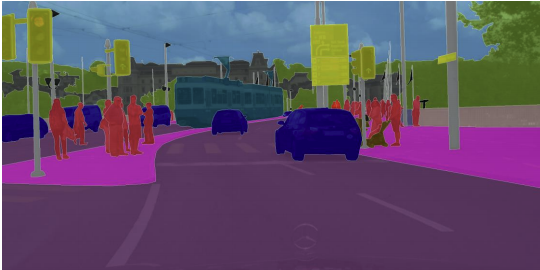This type of image classification is called semantic image segmentation. It's similar to object detection in that both ask the question: "What objects are in this image and where in the image are those objects located?," but where object detection labels objects with bounding boxes that may include pixels that aren't part of the object, semantic image segmentation allows you to predict a precise mask for each object in the image by labeling each pixel in the image with its corresponding class. The word “semantic” here refers to what's being shown, so for example the “Car” class is indicated below by the dark blue mask, and "Person" is indicated with a red mask:
Figure 1: Example of a segmented imageAs you might imagine, region-specific labeling is a pretty crucial consideration for self-driving cars, which require a pixel-perfect understanding of their environment so they can change lanes and avoid other cars, or any number of traffic obstacles that can put peoples' lives in danger.
By the time you finish this notebook, you'll be able to:
- Build your own U-Net
- Explain the difference between a regular CNN and a U-net
- Implement semantic image segmentation on the CARLA self-driving car dataset
- Apply sparse categorical crossentropy for pixelwise prediction
U-Net, named for its U-shape, was originally created in 2015 for tumor detection, but in the years since has become a very popular choice for other semantic segmentation tasks.
U-Net builds on a previous architecture called the Fully Convolutional Network, or FCN, which replaces the dense layers found in a typical CNN with a transposed convolution layer that upsamples the feature map back to the size of the original input image, while preserving the spatial information. This is necessary because the dense layers destroy spatial information (the "where" of the image), which is an essential part of image segmentation tasks. An added bonus of using transpose convolutions is that the input size no longer needs to be fixed, as it does when dense layers are used.
Unfortunately, the final feature layer of the FCN suffers from information loss due to downsampling too much. It then becomes difficult to upsample after so much information has been lost, causing an output that looks rough.
U-Net improves on the FCN, using a somewhat similar design, but differing in some important ways. Instead of one transposed convolution at the end of the network, it uses a matching number of convolutions for downsampling the input image to a feature map, and transposed convolutions for upsampling those maps back up to the original input image size. It also adds skip connections, to retain information that would otherwise become lost during encoding. Skip connections send information to every upsampling layer in the decoder from the corresponding downsampling layer in the encoder, capturing finer information while also keeping computation low. These help prevent information loss, as well as model overfitting.
Figure 2 : U-Net ArchitectureContracting path (Encoder containing downsampling steps):
Images are first fed through several convolutional layers which reduce height and width, while growing the number of channels.
The contracting path follows a regular CNN architecture, with convolutional layers, their activations, and pooling layers to downsample the image and extract its features. In detail, it consists of the repeated application of two 3 x 3 unpadded convolutions, each followed by a rectified linear unit (ReLU) and a 2 x 2 max pooling operation with stride 2 for downsampling. At each downsampling step, the number of feature channels is doubled.
Crop function: This step crops the image from the contracting path and concatenates it to the current image on the expanding path to create a skip connection.
Expanding path (Decoder containing upsampling steps):
The expanding path performs the opposite operation of the contracting path, growing the image back to its original size, while shrinking the channels gradually.
In detail, each step in the expanding path upsamples the feature map, followed by a 2 x 2 convolution (the transposed convolution). This transposed convolution halves the number of feature channels, while growing the height and width of the image.
Next is a concatenation with the correspondingly cropped feature map from the contracting path, and two 3 x 3 convolutions, each followed by a ReLU. You need to perform cropping to handle the loss of border pixels in every convolution.
Final Feature Mapping Block: In the final layer, a 1x1 convolution is used to map each 64-component feature vector to the desired number of classes. The channel dimensions from the previous layer correspond to the number of filters used, so when you use 1x1 convolutions, you can transform that dimension by choosing an appropriate number of 1x1 filters. When this idea is applied to the last layer, you can reduce the channel dimensions to have one layer per class.
The U-Net network has 23 convolutional layers in total.
The figures shown in the assignment for the U-Net architecture depict the layer dimensions and filter sizes as per the original paper on U-Net with smaller images. However, due to computational constraints for this assignment, you will code only half of those filters. The purpose of showing you the original dimensions is to give you the flavour of the original U-Net architecture. The important takeaway is that you multiply by 2 the number of filters used in the previous step. The notebook includes all of the necessary instructions and hints to help you code the U-Net architecture needed for this assignment.
What you should remember:
- Semantic image segmentation predicts a label for every single pixel in an image
- U-Net uses an equal number of convolutional blocks and transposed convolutions for downsampling and upsampling
- Skip connections are used to prevent border pixel information loss and overfitting in U-Net

